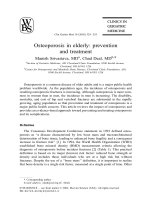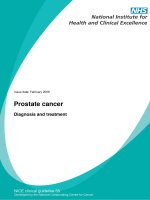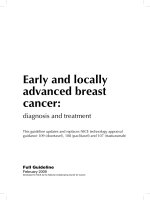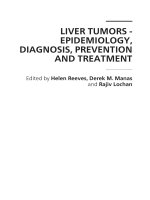GESTATIONAL DIABETES CAUSES, DIAGNOSIS AND TREATMENT pot
Bạn đang xem bản rút gọn của tài liệu. Xem và tải ngay bản đầy đủ của tài liệu tại đây (3.48 MB, 172 trang )
GESTATIONAL DIABETES -
CAUSES, DIAGNOSIS AND
TREATMENT
Edited by Luis Sobrevia
Gestational Diabetes - Causes, Diagnosis and Treatment
/>Edited by Luis Sobrevia
Contributors
Luis Sobrevia, Begum, Gregory Edward Rice, Murray Mitchell, Carlos Salomon, Keith Ashman, Sebastián Illanes,
Alexander Emeakpor Omu, Elaine Christine Dantas Moisés, Fabian Pardo, Andrea Leiva, Camila Diez De Medina, Carlos
Escudero
Published by InTech
Janeza Trdine 9, 51000 Rijeka, Croatia
Copyright © 2013 InTech
All chapters are Open Access distributed under the Creative Commons Attribution 3.0 license, which allows users to
download, copy and build upon published articles even for commercial purposes, as long as the author and publisher
are properly credited, which ensures maximum dissemination and a wider impact of our publications. However, users
who aim to disseminate and distribute copies of this book as a whole must not seek monetary compensation for such
service (excluded InTech representatives and agreed collaborations). After this work has been published by InTech,
authors have the right to republish it, in whole or part, in any publication of which they are the author, and to make
other personal use of the work. Any republication, referencing or personal use of the work must explicitly identify the
original source.
Notice
Statements and opinions expressed in the chapters are these of the individual contributors and not necessarily those
of the editors or publisher. No responsibility is accepted for the accuracy of information contained in the published
chapters. The publisher assumes no responsibility for any damage or injury to persons or property arising out of the
use of any materials, instructions, methods or ideas contained in the book.
Publishing Process Manager Ana Pantar
Technical Editor InTech DTP team
Cover InTech Design team
First published April, 2013
Printed in Croatia
A free online edition of this book is available at www.intechopen.com
Additional hard copies can be obtained from
Gestational Diabetes - Causes, Diagnosis and Treatment , Edited by Luis Sobrevia
p. cm.
ISBN 978-953-51-1077-4
free online editions of InTech
Books and Journals can be found at
www.intechopen.com
Contents
Preface VII
Section 1 GD Patient Care and Considerations 1
Chapter 1 GDM: Management Recommendations During Pregnancy 3
Mosammat Rashida Begum
Chapter 2 Multidisciplinary Care of Pregnant Women with Gestational
Diabetes Mellitus: Non-Pharmacological Strategies to Improve
Maternal and Perinatal Outcomes 17
Elaine Christine Dantas Moisés
Section 2 Cell and Molecular Mechanisms 27
Chapter 3 The Role of Placental Exosomes in Gestational Diabetes
Mellitus 29
Carlos Salomon, Luis Sobrevia, Keith Ashman, Sebastian E. Illanes,
Murray D. Mitchell and Gregory E. Rice
Chapter 4 The Adenosine–Insulin Signaling Axis in the Fetoplacental
Endothelial Dysfunction in Gestational Diabetes 49
Enrique Guzmán-Gutiérrez, Pablo Arroyo, Fabián Pardo, Andrea
Leiva and Luis Sobrevia
Chapter 5 Pro-Inflammatory Cytokines, Lipid Metabolism and
Inflammation in Gestational Diabetes Mellitus as Cause of
Insulin Resistance 79
Alexander E. Omu
Chapter 6 Maternal Hypercholesterolemia in Gestational Diabetes and
the Association with Placental Endothelial Dysfunction 103
A. Leiva, C Diez de Medina, E. Guzmán-Gutierrez, F. Pardo and L.
Sobrevia
Chapter 7 The Role of Placenta in the Fetal Programming Associated to
Gestational Diabetes 135
Carlos Escudero, Marcelo González, Jesenia Acurio, Francisco
Valenzuela and Luis Sobrevia
ContentsVI
Preface
Gestational diabetes (GD) is a syndrome characterized by glucose intolerance with on‐
set or first recognition during pregnancy. This definition is widely and properly used in
clinical terms. Something that at present is not well defined is the potential consequence
of GD in the fetal development and increased postnatal risks. The, by now, clearer con‐
cept regarding health alterations in adulthood due to an abnormal intrauterine environ‐
ment is something that indeed requires considering in order to better understand the
consequences of human diseases of pregnancy. GD is one of the syndromes associated
with altered phenotype at birth. Certainly, a proper management of these patients must
be considered in order to diminish the health risk for the mother and the fetus.
In this book the contributors have compiled several aspects that should be considered in
pregnancies with GD. The book is divided into two sections: (a) GD Patient Care and
Considerations, and (b) Cell and Molecular Mechanisms Behind this Syndrome. In the
first section (Chapter 1), Professor M.R. Begum (AKM Medical College, Dhaka, Bangla‐
desh) proposes several management recommendations for a better comprehension of the
diseases in pregnancy and its consequences. In this review, it is proposed that pregnan‐
cy progresses with changes in maternal carbohydrate occur and the placental hormones
act as contrainsulin factor leading to insulin resistance with a final increase in insulin
secretion. When this physiological compensation is inadequate, then GD develops. Un‐
fortunately, we do not have tools for an early diagnosis of GD, or, even more important‐
ly, a protocol that allows prevention of GD, but as soon as this syndrome is diagnosed or
recognized management is required. GD ends in a sort of associated alterations in the
mother (eg., preeclampsia, type 2 diabetes mellitus (DMT2) and others) and the fetus (eg.,
congenital anomaly, macrosomia and others). Thus, management of this syndrome aims
mainly at maintaining euglycemia, preventing obstetrical complications and reaching
optimal timing and appropriate mode of delivery. This chapter presents discussion
which addresses suggestions for the management of patients including counselling, the
role of nutrition and/or insulin therapy, or pharmacological treatment including oral an‐
tiadiabetic agents such as glybenclamide and metformin. In Chapter 2, Professor E.C.
Dantas Moisés (University of São Paulo, Brazil) proposes a multidisciplinary care of
pregnant women with the diagnosis of GD. Complementing the previous chapter, this
chapter includes non-pharmacological strategies to improve maternal and perinatal out‐
comes. Several aspects are touched in this concept, including nutrition. The chapter high‐
lights the need for healthy eating habits according to the nutritional needs, physical
activity as a strategy for prevention, and professional support from psychologists, nurses,
social workers, and multidisciplinary groups. It is proposed that prenatal care of wom‐
en is certainly required and that it is essential to provide information about the patho‐
physiology and prognosis of diabetes mellitus, either pregestational or gestational at this
stage. Indeed, the United Nations (UN) Secretary General of World Health Organiza‐
tion (WHO) organized a special session of the UN General Assembly (2011) to address
the control and prevention of non-communicable chronic diseases, presently the main
cause of death and loss of health, which highlighted the importance of the health status
of future mothers (i.e., pre-pregnancy) and its consequences on the health of fetus and the
newborn. There is certainly a need for this and more research centres formed by multi
and interdisciplinary groups should consider this concept.
In the second section of this book, five different contributions are presented referring to
cell and molecular mechanisms behind the genesis or consequences of GD. The contri‐
bution by Dr C. Salomon (University of Queensland, Australia) and colleagues (Chap‐
ter 3) explores the importance of new mechanisms of communication between the
trophoblasts and other cell types in the placenta in GD. One of the mechanisms dis‐
cussed in this chapter is the capacity of the trophoblasts to release nanovesicles includ‐
ing exosomes, and its potential putative utility in the diagnosis of disease onset and
treatment monitoring, including GD. The authors discuss the biogenesis and role of pla‐
cental exosomes as a mechanism to engage in local cell-to-cell communication and/or
distal interactions as release of placental exosomes into biological fluids and their trans‐
port to a remote site of action. The central idea behind this proposal is that placental-
derived exosomes may be of utility as diagnostic markers of GD in asymptomatic
pregnant women. A conclusion of this review leads us to ask whether nanovesicles re‐
leased from
the trophoblasts will modulate the function of endothelial cells of the hu‐
man placenta, especially in GD. In the section reviewed by Dr E. Guzmán-Gutiérrez and
colleagues (Pontificia Universidad Católica de Chile) (Chapter 4) a link between the bio‐
logical effects of insulin in the placenta vasculature and the endogenous nucleoside ade‐
nosine is proposed. GD is also a syndrome that occurs with maternal and fetal insulin
resistance and adenosine modulates the biological action of insulin on L-arginine/nitric
oxide (NO) signalling pathway (the L-arginine/NO signalling pathway) in human um‐
bilical vein endothelial cells (HUVECs) from normal pregnancies. Thus, the authors pro‐
pose that GD associates with endothelial dysfunction in the fetoplacental macro and
microcirculation and further suggest the involvement of A2A adenosine receptors and
insulin receptors as a mechanism explaining the increase of NO synthesis (i.e., potential
modulation of the reported ALANO pathway (Adenosine/L-Arginine/Nitric Oxide) (San
Martín & Sobrevia, Placenta, 2006). It is also discussed that insulin has a dual effect re‐
garding modulation of L-arginine transport and NO synthesis in HUVECs. This is ex‐
plained by a potential differential expression of insulin receptor isoforms A (IR-A) and
IR-B in normal and GD pregnancies, as confirmed in recent studies in HUVECs (Wester‐
meier et al, Diabetes, 2011) and human placental microvascular endothelial cells (Salo‐
mon et al, PLoS ONE, 2012). In fact, since insulin effects are dependent on activation of
adenosine receptors in several cell types, including HUVECs (Guzmán-Gutiérrez et al,
PLoS ONE, 2012), it is suggested that a differential regulation of expression and/or activ‐
ity of insulin receptor isoforms by activation of adenosine receptors could be used as a
strategy to improve GD deleterious effects in the mother and the fetus. In these terms,
Professor A. Omu (Kuwait University, Kuwait) (Chapter 5) proposes that a complemen‐
tary action is required, including mechanisms and consequences of alterations in lipid
metabolism during pregnancy, which associates diabetes
in pregnancy with obese pa‐
PrefaceVIII
tients. Furthermore, inflammation-induced insulin resistance is also reviewed in this
chapter and a potential correlation with the epidemic of obesity is proposed (Pardo et al,
J Diab Metab, 2012). Professor Omu also highlights the need for genetic studies to identi‐
fy subjects with candidate genes for diabetes and epigenetic factors that may affect gene
expression and predisposition to inflammation. Early recognition and management of
women predisposed to develop diabetes is crucial for prevention or delaying insulin
resistance and development of glucose intolerance. The epidemiology, genetics and im‐
munological basis of GD, the role of lipid metabolism and lipid peroxidation, oxidative
stress on antioxidant gene expression and other inflammatory cytokines, as well as the
role of risk factors such as obesity and adipokynes, proinflammatory cytokines, and the
role of intervention strategies in the prevention of progression of GD to DMT2 and ma‐
ternal effects of GD is extensively reviewed and proposed in this review. In the chapter
by Dr A. Leiva and colleagues (Pontificia Universidad Católica de Chile) (Chapter 6) the
role of maternal plasma cholesterol levels in pregnancy is analysed. Maternal supraphy‐
siological hypercholesterolemia (MSPH) occurs with pathologies including GD. Since GD
is also associated with endothelial dysfunction of the placenta mainly triggered by dys‐
lipidemia, it is proposed that MSPH could play a role in this phenomenon since dyslipi‐
demia is a risk factor in developing endothelial dysfunction and atherosclerosis. The
main topic of this review highlights the fact that atherogenesis, a clinical complication
commonly appearing in adults, might begin in fetal life with similar factors altered at the
mother, the fetus and the placenta. Another proposal is the fact that umbilical veins could
potentially be altered by MSPH. This is rather new in the literature and the mechanisms
are unknown; however, umbilical vein as a model of fetal arteries (i.e., carrying fetal
blood rich in oxygen) could represent a biological substrate for studying the mecha‐
nisms associated with fetal atherosclerosis biogenesis. The authors describe alterations in
the L-arginine/NO pathway and the role of arginases in this phenomenon. These mecha‐
nisms have not been evaluated in GD occuring with hypercholesterolemia (Leiva et al,
Exp Diab Res, 2011). Finally, the review by Dr C. Escudero (Universidad del Bío-Bío,
Chile) and colleagues (Chapter 7) supports several aspects of the information described
in previous chapters and includes general and specific ideas regarding dysfunction of the
endothelial cells from the microvasculature of the human placenta in GD. This review
summarizes the available literature focused on the role of feto-placental endothelial dys‐
function as the possible main factor in the generation of short-term complication during
GD and certainly speculates how it may program the response of the fetus to a ‘GD
environment’. Several aspects are put in
a well coordinated description of mechanisms,
anatomy and histology of the placenta, changes in blood flow, the role of oxidative stress,
with a description of placental angiogenesis involving adenosine (Escudero et al, Biofac‐
tors, 2012).
A final general remark of chapters in this book is, in fact, that GD is a syndrome caused
by a not well-understood multifactor mechanism. However, common strategies seem to
be key in the understanding of the syndrome, i.e., endothelial dysfunction and the role of
other placenta cells such as trophoblasts. A proper and knowledge-based management of
the syndrome for the well being of the mother and the fetus is fully needed. In addi‐
tion, pre-pregnancy and antenatal screening of women is required. This is not only to
improve the management and outcome of the pregnancy but also to optimize life-long
health and well being, considering the inter-generational consequences. Thus, pre-preg‐
Preface IX
nancy health and nutrition are key conditioning factors for fetal development and the
health of the newborn, which are, in turn, major determinants of adult chronic diseases.
Professor Luis Sobrevia
Cellular and Molecular Physiology Laboratory (CMPL)
Division of Obstetrics and Gynaecology
School of Medicine, Faculty of Medicine
Pontificia Universidad Católica de Chile
Santiago, Chile.
Honorary Professor
The University of Queensland Centre for Clinical Research
Herston, QLD, Australia.
Acknowledgments
The contents of this book have been made possible thanks to the generous contributions
of all authors, who have made a dedicated effort to compile information focused on the
central topic of the book. Special thanks are given to the Division of Obstetrics and Gyne‐
cology of the School of Medicine of the Faculty of Medicine, Pontificia Universidad Catól‐
ica de Chile for the support to proceed with this project. Secretarial assistance (Mrs
Ninoska Muñoz) in the editorial process of these reviews was partially provided from
Fondo Nacional de Desarrollo Científico y Tecnológico (FONDECYT 1110977) and Pro‐
grama de Investigación Interdisciplinario (PIA) from Comisión Nacional de Investigación
en Ciencia y Tecnología (CONICYT, Anillos ACT-73) (Chile).
PrefaceX
Section 1
GD Patient Care and Considerations
Chapter 1
GDM: Management Recommendations During
Pregnancy
Mosammat Rashida Begum
Additional information is available at the end of the chapter
/>1. Introduction
Gestational diabetes mellitus (GDM) is currently defined as any degree of glucose intolerance
with onset or first recognition during current pregnancy [1-4]. Pregnancy induces progressive
changes in maternal carbohydrate metabolic process. As pregnancy advances insulin resist‐
ance and diabetogenic stress due to placental contra-insulin hormones necessitate compensa‐
tory increase in insulin secretion. When this compensatory mechanism fails due to pancreatic
β cells inadequacy gestational diabetes develops. GDM affects 1-2% of all pregnancies. In
majority of patients it is mild and can be adequately controlled with diet alone but a minority
will require antidiabetogenic agents like glyburide or insulin.
Abnormalities of carbohydrate metabolism occur during pregnancy lead to glucose intoler‐
ance. Due to diabetogenic effect of pregnancy about 3-5% of all pregnant women show glucose
intolerance and approximately 90% of these women have GDM. Majority of these women will
have normal carbohydrate tolerance after delivery. However, 50% of women with GDM will
develop type 2 DM later in their life. Asian women are ethnically more prone to develop
glucose intolerance compared to other ethnic groups. Due to many adverse effects of GDM on
mother and foetus early diagnosis and appropriate management is essential for improved
outcome of pregnancy.
2. How does pregnancy cause carbohydrate intolerance?
As pregnancy advances it causes
a. Increased insulin resistance due to
© 2013 Begum; licensee InTech. This is an open access article distributed under the terms of the Creative
Commons Attribution License ( which permits unrestricted use,
distribution, and reproduction in any medium, provided the original work is properly cited.
1. Antagonistic effect of increased production of human placental lactogen
2. Anti-insulin effect of increased production of placental cortisol, oestriol and proges‐
terone.
3. Increased insulin catabolism by placental and renal insulinase [5]
b. Increased blood glucose level because
1. Mother utilized fat for her caloric requirements and saves glucose for her foetus.
As a result of these physiological changes the normal blood sugar pattern in pregnant woman
is Fasting - 65 ± 9mg/dl, non fasting - 80 ± 10 mg/dl, postprandial - 140 ± 10 mg/dl [6].
3. Adverse effects of GDM
Carbohydrate intolerance during pregnancy or GDM causes significant increases in foetal and
maternal morbidity. The maternal consequences are
• Preeclampsia: 10-25% of all pregnant diabetes.
• Infection: High incidence of chorioamnionitis and postnatal endometritis.
• Polyhydramnios
• Postpartum bleeding- High incidence due to exaggerated uterine distension.
• Caeserean section: High incidence due to fetal cause.
• Delayed wound healing or wound dehiscence if GDM is not controlled
• Long term effect is type 2 DM.
Fetuses are much more affected than mothers. The fetal consequences are
• Congenital anomaly: It is associated with poor glycemic control and end organ damage.
• Macrosomia: It is defined as a birth weight greater than or equal to 4000 g. Incidence is
17-29% of pregnancies with GDM as compared with 10% in the nondiabetic population [7].
• Hypoglycemia The incidence of neonatal hypoglycemia is greater in GDM than normal
pregnancies [8].
• Hypocalcaemia
• Hyaline membrane disease
• Apnea and bradycardia
• Traumatic delivery: The incidence of shoulder dystocia with brachial plexus damage and
clavicular fractures are increased in neonates of women with GDM [9]
• Stillbirth
Gestational Diabetes - Causes, Diagnosis and Treatment4
The neonatal morbidity is assessed by a composite outcome that includes stillbirth, neonatal
macrosomia or LGA, neonatal hypoglycemia, erythrocytosis and hyperbilirubenemia. Langer
et al found composite morbidity in 59% of untreated GDM, 18% of treated GDM and in 11%
of non-diabetic subjects [9]. The most common complication was macrosomia which affected
46% and 19% of the newborns from untreated and treated mothers with GDM respectively.
4. How to diagnose GDM?
To diagnose GDM first of all screening is done to detect the potential cases for GDM. A number
of screening procedures and diagnostic criteria are followed in different countries like
American Diabetes Association (ADA), World Health Organization (WHO), Canadian
Diabetes Association (CDA), National Diabetes Data Group (NDDG) and Australian criteria.
Two types of screening methods are adopted by different populations. In selective screening,
only high risk populations are screened and in universal screening, all pregnant women are
included. American Diabetes Association (ADA) recommends screening of selective (High
risk) population. But compared to selective screening, universal screening for GDM detects
more cases and improves maternal and neonatal prognosis [10]. So universal screening appears
to be the most reliable and desired method for detection of GDM [11].
ADA screening: ADA recommends two step screening.
Step1:- A 50 gm glucose challenge test (GCT) is used for screening without regard to the time
of last meal or time of the day [12)
Step 2:-If 1hour GCT value is more than 140 mg/dl, 100 g oral glucose tolerance test (OGTT) is
recommended and plasma glucose is estimated at 0,1,2 and 3 hours. GDM is diagnosed if any
2 values meet or exceed fasting plasma glucose (FPG) >95 mg/dl, 1 hour postparandial glucose
(PG)> 180 mg/dl, 2 hour PG> 155 mg/dl and 3 hour PG >140 mg/dl. But drawback of this method
is that, the glycaemic control cut-off was originally validated against the future risk of mother
only and on the foetal outcome [13]. Other problems are the number of blood samples
requirement is more, 1 for screening and 4 for 3 hour OGTT to confirm the diagnosis. Moreover,
patients have to visit the antenatal clinic at least on two occasions for diagnosis leading to their
inconvenience.
WHO procedure: To standardize the diagnosis of GDM the World Health Organization
(WHO) recommends using a 2 hour OGTT with a threshold plasma glucose concentration of
greater than 140 mg/dl at 2 hours, similar to that of impaired glucose tolerance (IGT) in non
pregnant state [14]. WHO procedure also was not based on maternal and foetal outcome but
probably the criteria was recommended for its easy adaptability in clinical practice. WHO
criteria of 2 hour plasma glucose ≥140 mg/dl identifying a large number of cases may have
greater potential for prevention of GDM [15].
A single test procedure for diagnosis of GDM: All the diagnostic criteria require the women
to be fasting. For successful implementation of universal screening the procedure should not
impose any restriction. So a single test 2-hours after 75 g glucose in a non-fasting state
GDM: Management Recommendations During Pregnancy
/>5
irrespective of last meal can make the diagnostic procedure simple, feasible and economical.
It serves as both screening and diagnostic procedure, causes least disturbance to a pregnant
woman’s routine activities and avoids the inconvenience of fasting in a pregnant woman. It
was found that there was no significant difference in PG level between 75g glucose testing in
fasting and non-fasting state, irrespective of last meal timing [16]. Performing this test
procedure in the non-fasting state is rational, as glucose concentration are affected little by the
time since last meal in a normal glucose tolerant woman, whereas meal timing affects in a
woman with GDM [17] The non-fasting 2-h post 75 g glucose correctly identified subjects with
GDM [18] and strongly predict adverse outcome for the mother and her offspring [19]. Thus,
the single test procedure performed irrespective of the last meal timing is seems to be a more
rational and patient friendly approach.
Diagnosis Fasting plasma glucose (FPG)
(Mg/dl)
2-hour plasma glucose (PG)
(Mg/dl)
Normal glucose tolerance (NGT) <100 <140
Impaired fasting glucose (IFG) 100-125
Impaired glucose tolerance (IGT) 140-199
Diabetes mellitus (DM) ≥126 ≥200
Table 1. Classification of glucose intolerance by 75gm 2 hour oral glucose tolerance test(OGTT)
5. When to screen in pregnancy?
Increasing maternal carbohydrate intolerance in pregnant woman without GDM is associated
with adverse maternal and foetal outcome [20]. By following the usual recommendation for
screening between 24-28 weeks of gestation many early onset of GDM and pre pregnant
unidentified diabetes mellitus (DM) can be missed, which may adversely affect foetal outcome.
Seshiah et al detected 16.3% glucose intolerance within 16 weeks of pregnancy [21]. Other two
studies reported about 40% to 66% of women with GDM can be detected early during
pregnancy [22,23]. Nahum et al suggested that the ideal period to screen for GDM is around
16 weeks of gestation and even earlier in high-risk groups with a history of foetal wastage [23].
GDM diagnosis may not be missed by screening around 24-28 weeks of gestation but a
substantial number of pregnant women who develop GDM in the earlier weeks of gestation
are likely to have delayed diagnosis and may not receive appropriate medical care. So it is safe
to screen for GDM during early weeks of pregnancy as by early detection of glucose intolerance
during pregnancy and adequate care to the antenatal women a good foetal outcome can be
achieved similar to that of normal glucose tolerance (NGT) pregnant women [24, 25]. If a
woman is found to have normal glucose tolerance test in the first trimester, she should be tested
for GDM around 24
th
-28
th
weeks and around 32
nd
-34
th
weeks and also in later weeks if
necessary, particularly when rapid weight gain occurs or foetal macrosomia is suspected [26].
Gestational Diabetes - Causes, Diagnosis and Treatment6
It has been suggested that women at high risk should be screened as soon as pregnancy is
confirmed [27].
6. High risk GDM
Gestational diabetes is a complication during pregnancy which affects both mother and foetus.
From foetal point of view adverse affects are sometimes severe and fatal. Some GDM patients
are at higher risk for complications than others. High risk GDM patients are those who have
the
• History of stillbirth, neonatal death and foetal macrosomia in previous pregnany
• Maternal obesity and hypertension
• Development of oligohydramnios, polyhydramnios, preeclampsia
• Inadequate metabolic control by diet alone.
Women at high risk should be identified soon after the diagnosis is made, because they need
meticulous management to prevent such complications, need antepartum foetal surveillance
testing and may require delivery before their expected date of delivery.
7. Management strategies
To prevent maternal and fetal complications treatment at appropriate time is necessary. Early
detection of glucose intolerance during pregnancy and instillation of treatment at earliest state
can prevent the complications and a good fetal outcome can be achieved.
So, aim of management is to
• Maintain euglycemia
• Prevent obstetrical complications
• Fix optimal time and appropriate mode of delivery
Management includes
1. Counseling of the patient
It is important to counsel the patient with GDM about the condition and its management, so
that they can acquire a clear understanding of the characteristics and demands be emphasized
on
1. the importance of exercise and diet control
2. importance of blood glucose control
3. self monitoring of blood glucose
GDM: Management Recommendations During Pregnancy
/>7
4. identification and treatment of hypoglycemia.
2. Treatment of blood glucose control
The fundamental objective of the care of every insulin dependent pregnant diabetic is control
of blood glucose to a desirable level for good fetal outcome. The aim is to maintain the fasting
glucose level between 80-90mg/dl and 2 hours postprandial glucose level between 110-129mg/
dl.
7.1. Medical Nutrition Therapy (MNT)
Dieting is an important step for blood glucose control. But pregnancy needs extra calories for
growth and development of fetus. So GDM patients need strict maintenance of diet to maintain
adequate calories without affecting blood glucose level to have a healthy baby. The concept of
dietary management of the GDM or any other diabetic pregnant woman is that a healthy diet
for them is not different from a healthy diet for any other non-diabetic pregnant woman.
Patients should know that carbohydrate containing food increase blood glucose levels above
normal limits and that persistently abnormal elevation of the blood glucose levels are harmful
both for mother and foetus. So to prevent abnormal glucose levels a food plan should be made
to maintain adequate calories without affecting blood glucose levels. Patient needs to under‐
stand the quantity or servings of carbohydrate present in her meals and snacks and the effect
of different types of carbohydrate on her blood glucose levels.
The meal pattern should provide adequate calories and nutrients to meet the needs of
pregnancy. The expected weight gain during pregnancy is 300-400g/week and total weight
gain is 10-12 kg by term. So the meal plan aims to provide sufficient calories to sustain adequate
nutrition for the mother and foetus and to avoid excess weight gain and postprandial hyper‐
glycemia. Calculation of daily caloric intake is based on body weight, age, physical activities
and gestational age. Approximately 30-40 kcal/kg and an increment of 300 kcal/day above the
basal requirement are needed in 2
nd
and 3
rd
trimester. For majority of women with GDM the
optional total daily caloric intake will be between 2000 and 2500 cal/day. The total caloric intake
is split into three meals and one to three snacks depending on the patient’s habit. In a non-
diabetic woman the peaking of the plasma glucose is high after breakfast due to “Dawn
phenomenon’’and the insulin secretion also matches the glycemic excursion that occurs with
the meal [28]. But GDM mothers have deficiency in first phase insulin secretion leads to
increased postprandial glucose level after heavy breakfast. To avoid the postprandial plasma
glucose peaking with breakfast, it can be split into two halves and consuming these portions
with a two-hour gap. By this, the undue peak in plasma glucose levels after ingestion of the
total quantity of breakfast at one time is avoided.
The total daily caloric allowance should be distributed among the different foods groups in
such a way that approximately 40-50% of the calories come from complex carbohydrate. The
carbohydrate component of the diet should be distributed as 10-15% at breakfast, 20-30% at
lunch and 30-40% at dinner. Approximately 30-40% from fat and the rest from protein.
Postprandial elevations of blood sugar are due almost exclusively to the carbohydrate content
of the diet. So carbohydrate should be taken as small frequent meal. Growthwer et al showed
Gestational Diabetes - Causes, Diagnosis and Treatment8
the benefit of MNT is series of 1000 pregnant women in comparison to routine care. Serious
complications were 1% in MNT and 4% in routine care. Macrosomia rate was 10% in MNT and
21% in routine care. There was no perinatal death in MNT group whereas 5 perinatal deaths
were in routine care [29]. Benefits of MNT are
• Decreases hospital admission.
• Decrease in insulin use.
• Improved likelihood of normal foetal and placental growth.
• Reduced risk of perinatal complications specially when diagnosed and treated early
7.2. Oral antidiabetic agents
Oral hypoglycemic agents can be used to control blood glucose where nutritional therapy is
failed. Two important agents are used.
Glibenclamide: Glibenclamide (Glyburide) is safe therapy for many GDM women. This drug
decreases the insulin resistance and improves insulin secretion. Placental transfer of glyben‐
clamide is negligible. Langer et al concluded that glyburide is as effective as insulin in
maintaining the desired glycemic levels and resulted in a comparable outcome [30]. Only 4%
of women in the glyburide group were not adequately controlled and required insulin. The
usual starting dose of glyburide is 2.5 mg once or twice daily. A randomized clinical trial
comparing the effect of insulin and glyburide showed equally good glycemic control and
similar perinatal outcome [31]. The total daily dose may be increased up-to 20 mg if necessary.
The peak plasma level occurs 2-4 hours after administration and duration of action is 10-12
hours. Women with fasting hyperglycemia but normal postprandial blood glucose may do
well with a single dose of glyburide at bed time. Glyburide is a sulfonylurea and its primary
mechanism of action is stimulation of the release of insulin from the storage granules of
pancreatic beta cells. Secondarily it decreases insulin resistance. It is nonteratogenic and is
classified as a category B drug. The main side effect of glyburide is hypoglycemia.
Metformin: Though use of metformin in pregnancy is controversial, studies shows that it can
prevent the development of GDM in high risk for developing that. There were no adverse
effects to fetus and mother [32, 33]. Metformin trial in gestational diabetes found that in women
with GDM, metformin was not associated with increased peinatal complications as compared
with insulin [34]. Usual dose is 500 mg to 1500 mg daily in divided doses. Metformin appears
to suppress hepatic glucose uptake and decreases intestinal absorption of glucose. It is also a
category B drug and it does not cause hypoglycemia. More studies needed before recommen‐
dation for routine use in pregnancy.
7.3. Insulin therapy
Once diagnosis is made, nutrition therapy is advised. If it fails oral antidiabetic agents can be
tried. If oral agents failed to acheive FPG of ≤ 5.0 mmol/L and 2-h postprandial glucose level
of ≤ 6.7 mmol/L insulin is to be started. The aim is to maintain the postprandial peak plasma
GDM: Management Recommendations During Pregnancy
/>9
glucose level of ≤ 6.7 mmol/L. Human insulin is the insulin of choice for the first time. Most
patients require a mixture of intermediate (NPH) and regular (short acting) insulin twice daily.
It is preferable to start with premix insulin (mixture of NPH and regular insulin) of any brand.
Usually women with GDM do not require >20 unit insulin per day for glycemic control [35].
Recommended dosing schedule is two thirds of the total insulin dose is to be given in the
morning and remainder before dinner. The morning dose should be two thirds NPH and one
third short acting insulin and the pre-dinner dose should be equal parts NPH and short acting
insulin. However, dose schedule requires modification according to patent’s BMI, glucose level
and life style.
Insulin analogue: If postprandial glucose is still not under control, rapid acting insulin
analogue is to be considered. Rapid acting insulin analogues (Aspart-Novorapid, Lispro-
Humalog) have been found to be safe and effective during pregnancy. Pregestational diabetic
women during pregnancy may require high dose of insulin. A few may require multiple-daily
injections usually given as short acting insulin before breakfast and lunch and intermediate
acting insulin or premix before dinner. Insulin dose is always individualized and has to be
adjusted according to need of the patient.
8. Monitoring of glycemic control:
8.1. Measuring blood glucose level
Meticulous monitoring is essential to achieve desired level of plasma glucose and to prevent
post-insulin hypoglycemia. The success of treatment for a woman of GDM depends on
glycemic control. Two hours postprandial blood glucose monitoring is preferable as the
diagnosis of GDM is also based on two hour plasma glucose. GDM women have high post-
breakfast plasma glucose level compared to post lunch and post dinner. So increased morning
dose of short acting insulin is needed together with careful adjustment of meal timing and
snacks to avoid hypoglycemia.
Once targeted blood glucose level is achieved woman with GDM require monitoring of both
fasting and 2-h post breakfast glucose once in a month till 28
th
weeks of gestation. After 28
th
weeks blood glucose monitoring should be done fortnightly or more frequently if needed.
After 32 weeks blood glucose monitoring should be done once a week till delivery. In high risk
pregnancies continuous glucose monitoring may be needed to know the glycemic fluctuations
and to plan proper insulin dosage.
8.2. Measuring HbA1c
A1c level is useful in monitoring the glucose control during pregnancy, but not for the day to
day management. It serves as a prognostic value. In euglycemic state A1c value should be
≤6%. In early weeks of pregnancy A1c level is helpful to differentiate GDM from pre-pregnant
diabetes. If A1c level is more than 6% it indicates that woman is pre GDM [36]. Though
treatment approach is not changed based on A1c level.
Gestational Diabetes - Causes, Diagnosis and Treatment10
8.3. Foetal surveillance
The management of GDM, based on the foetal growth and developmental defect if there is any.
USG is the key diagnostic tool to detect developmental defect as well as to monitor the foetal
growth. Low risk GDM patients who have glycemic control with diet alone and who do not develop
any complications like polyhydaramnios, pre-eclampsia or macrosomia need ultrasonogram
around 24 weeks of gestation and thereafter as needed. High risk GDM patients who are on insulin
or oral antidiabetic agent should have antepartum foetal surveillance by ultrasonogram in every
trimester. A foetal echo is a must at 24 weeks to rule out congenital defect. In last trimester
biophysical profile is recommended twice in a week or weekly if foetus is at risk.
8.4. Timing of delivery
Low risk or uncomplicated GDM patients may be allowed to develop spontaneous labour and
to deliver at term. There is no need to deliver before term unless there is evidence of macro‐
somia, polyhydarmnios, poor glycemic control or other obstetric complications like, pre-
eclampsia or intrauterine growth retardation. Once the uncomplicated GDM patient reaches
40 weeks labour should be induced if cervix is ripe. If cervix is not ripe and estimated foetal
weight (EFW) is >4000 gm elective caesarean section is to be done. High risk GDM patients
should have their labour induced when they reach 38 weeks. Again C/S is to be done if EFW
is >4000 gm. Preterm pregnancy termination may be needed in GDM with complications like
pre-eclampsia, polyhydramnios, foetal compromise ( less foetal movement) and uncontrolled
diabetes. Glucocorticoid for 48 hours should be administered to accelerate lung maturity in
preterm termination. Insulin requirement may be increased due to hyperglycemin effect of
glucocorticoids. Spontaneous preterm labour is common in patient with GDM. Tocolysis in
the form of magnesium sulphate or nifedipine can be used in preterm labour to delay delivery
so that glucocorticoid therapy to accelerate lung maturity can be administered over 48 hours.
8.5. Management during labour
Most insulin treated GDM do not need insulin during labour and after delivery. During labour
it is essential to monitor blood glucose every 2-4 hours. Upward deviations from normal are
corrected with small doses of regular insulin or low dose IV insulin to maintain blood glucose
between 100 and 120 mg/dl. If blood glucose is >120-140mg/dl, 4 unit insulin, if
>140-180mg/dl 6 unit insulin and if >180 mg/dl 8 unit insulin is to be given in a drip of normal
saline at a rate of 16-20 drops/m. Maternal capillary blood glucose is to be checked by gluc‐
ometer every 1 hour and drip rate is to be adjusted. Dextrose infusion should be avoided. If it
is given neutralizing dose of insulin is to be given. 1 unit insulin is needed to neutralize 2.5g
glucose. So to neutralize the glucose of 1000 ml 5% dextrose saline 20 unit insulin is to be added
with the drip. Drip rate is to be judged according to patient’s requirement. Oral feeding is to
be started as early as possible to avoid infusion of fluid. Monitoring should be done after
delivery and 24 hours postpartum. Usually blood glucose level falls to baseline after delivery.
8.6. Neonatal management
A neonatologist should be present during delivery as GDM is a high risk pregnancy and there
is chance of neonatal morbidity. Neonates are at risk of all complications similar to the infants
GDM: Management Recommendations During Pregnancy
/>11
born to mothers with overt diabetes [37]. Neonates should be monitored closely after delivery
for respiratory distress. Capillary blood glucose should be monitored at 1, 2 and 4 hours after
birth and before starting of feeding. Cut-0ff value is 2.6 mmol. Early breast feeding is strongly
encouraged. If mother’s blood glucose is not normalized insulin is advisable in lactating
woman for good glycemic control.
9. Prevention of type 2 Diabetes Mellitus (DM)
There is increased risk of development of type 2 DM in patients of GDM [38] and incidence of
type 2 DM is about 44% in patients who required insulin or OHA or onset of GDM before 24
weeks [39]. GDM may also recur in a future pregnancy and approximately 55% of patients
who were obese or with macrosomic infants will have GDM in subsequent pregnancy [40]. So
it is important to perform a 75 g GTT at 6-8 weeks postpartum. If found normal, GTT is repeated
after 6 months and every year to assess glucose tolerance. Patients should be informed that
about 40-60% of them will have overt diabetics when they are in their 5
th
decades. Weight loss,
dietary control and exercise will obviously help to prevent overt diabetes later in life [41]. GDM
has a far reaching consequence in predisposing their offsprings to glucose intolerance. Debelea
et al found that more than 50% children who were born to women with GDM developed type
2 DM by the age 35 [42]. The important aspect of GDM is that the intrauterine milieu whether
one of nutritional deprivation or nutritional plenty, results in foetal pancreatic development
and peripheral response to insulin that may lead to adult onset GDM and type 2 DM[43]. So
the timely action in all pregnant women with glucose intolerance to achieve euglycemia may
prevent transmitting glucose intolerance from one generation to another [44].
GDM women are at increased risk of future type 2 diabetes mellitus and their children are also
at risk of developing type 2 DM later in their life. Universal screening for GDM at early weeks
of gestation can detect more cases at an early stage leading to early interventions and hence
improves maternal and foetal outcome as early detection leads to early treatment and prevent
complications and adverse effect to mother and foetus. A 2-hour 75g post glucose ≥7.8mml/L
serves both as screening and diagnostic criteria which is a simple and economical one step
procedure. Early detection and treatment of GDM can only prevent the all probable compli‐
cations and the vicious cycle of transmitting glucose intolerance from generation to generation.
Author details
Mosammat Rashida Begum
*
Address all correspondence to:
AKM Medical College, Dhaka, Bangladesh
Gestational Diabetes - Causes, Diagnosis and Treatment12
References
[1] American Diabetes AssociationDiagnosis and classification of diabetes mellitus. Dia‐
betes Care. (2006). Suppl 1:S, 43-8.
[2] American College of Obstetricians and Gynecologists Committee on Practice Bulle‐
tins-ObstetricsACOG Practice Bulletin. Clinical management guidelines for obstetri‐
cian-gynecologists. September (2001). replaces Technical Bulletin Number 200,
December 1994). Gestational diabetes. Obstet Gynecol. 2001;, 98(30), 525-38.
[3] Metzger, B. E, & Coustan, D. R. Summary and recommendations of the Fourth Inter‐
national Workshop-Conference on Gestational Diabetes Mellitus. The Organizing
Committee. Diabetes Care. (1998). Suppl 2:B, 161-7.
[4] Metzger, B. E, Buchanan, T. A, Coustan, D. R, De Leiva, A, Dunger, D. B, Hadden, D.
R, et al. Summary and recommendations of the Fifth International Workshop-Confer‐
ence on Gestational Diabetes Mellitus. Diabetes Care. (2007). Suppl 2:S, 251-60.
[5] Arias, F, Daftary, S. N, & Bhide, A. G. Practical guide to high risk pregnancy and de‐
livery- A South Asian perspective. Elsevier, (2008). Diabetes and pregnancy, ,
440-464.
[6] Cousins, L, Rigg, L, Hollingsworth, D, et al. The 24 hour excursion and diurnal
rhythm of glucose, insulin and C-peptide in normal pregnancy. Am j Obstet gynecol
(1980).
[7] Adams, K. L, Hongshe, L, Nelson, R. L, et al. Sequelae of unrecognized gestational
diabetes. AM J Obstet Gynecol (1998). , 178, 1321-32.
[8] Garner, P, Okun, N, Keely, E, et al. A randomized controlled trial of strit glycemic
control and tertiary level obstetric care versus routine obstetric care in the manage‐
ment of gestational diabetes: a pilot study. AM J Obstet Gynecol (1997). , 177, 190-95.
[9] Langer, O, & Yogev, . . Gestational diabetes: the consequences of not treating. AM J
Obstet Gynecol 2005;192:989-97.
[10] Dorendra Singh IBidhumukhi Devi Th, Ibeyaima Devi Kh, Premchand Singh Th. Sci‐
entific Presentation Volume of the First National Conference of the DIPSI, February
(2006). Chennai. 68.
[11] Shamsuddin, K, & Mahdy, Z. A. Siti Rafiaah, I.; et al. Risk factor screening for abnor‐
mal glucose tolerance in pregnancy. Int J Gynecol Obstet. (2001). , 75, 27-32.
[12] Swami, S. R, Mehetre, R, Shivane, V, Bandgar, T. R, Menon, P. S, & Shah, N. S. Preva‐
lence of Carbohydrate Intolerance of Varying Degrees in Pregnant Females in West‐
ern India (Maharashtra)- A Hospital-based Study. J Indian Med Assoc (2008). , 106,
712-4.
GDM: Management Recommendations During Pregnancy
/>13
[13] Divakar, H, Tyagi, S, Hosmani, P, & Manyonda, I. T. Diagnostic criteria influence
prevalence rates for gestational diabetes: implications for interventions in an Indian
pregnant population. Perinatology (2008). , 155-61.
[14] Beischer, N. A, Oats, J. N, Henry, O. A, Sheedy, M. T, & Walstab, J. E. Incidence and
severity of gestational diabetes mellitus according to country of birth in women liv‐
ing in Australia. Diabetes (1991). Dec; 40 Suppl , 2, 35-8.
[15] Metzger, B. E, & Coustan, D. R. Summary and Recommendations of the Fourth Inter‐
national workshop-Conference on Gestational Diabetes Mellitus. Diabetes Care
(1998). B, 161-167.
[16] Anjalakshi, C, Balaji, V, Balaji, M. S, et al. A single test procedure to diagnose gesta‐
tional diabetes mellitus. Acta Diabetol. (2009). , 46(1), 51-4.
[17] Seshiah, V, & Balaji, V. Madhuri S Balaji, Sanjeevi CB, Green A. Gestational Diabetes
Mellitus in India. JAPI (2004). , 52, 707-11.
[18] Pettitt, D. J, Bennett, P. H, Hanson, R. L, et al. Comparison of World Health Organi‐
zation and National Diabetes Data Group procedures to detect abnormalities of glu‐
cose tolerance during pregnancy. Diabetes Care.(1994). , 17(11), 1264-68.
[19] Pettitt, D. J, Bennett, P. H, Saad, M. F, et al. Abnormal glucose tolerance during preg‐
nancy in Pima Indian women: Long term effects on the offspring. Diabetes.(1991). ,
40(2), 126-130.
[20] Gestational Diabetes Mellitus: American Diabetes Association- Clinical Practice Rec‐
ommendations 2002; Diabetes Care 25 (1): S94-96.
[21] Seshiah, V, Balaji, V, Balaji, M. S, et al. (2007). Gestational Diabetes Mellitus manifests
in all trimesters of pregnancy. Dia Res Clin Pract.2007;, 77(3), 482-4.
[22] Super, D. M, Edelberg, S. C, Philipson, E. H, et al. Diagnosis of gestational diabetes in
early pregnancy. Diabetes Care.(1991). , 14(4), 288-94.
[23] Nahum, G. G, Wilson, S. B, & Stanislaw, H. Early pregnancy glucose screening for
gestational diabetes mellitus. J Reprod Med.(2002). , 47(8), 656-62.
[24] Seshiah, V, Alexander, C, Balaji, V, et al. Glycemic control from early weeks of gesta‐
tion and pregnancy outcome. Diabetes.(2006). Supp1):604
[25] Seshiah, V, Cynthia, A, Balaji, V, et al. Detection and care of women with gestational
diabetes mellitus from early weeks of pregnancy results in birth weight of newborn
babies appropriate for gestational age. Dia Res Clin Pract. (2008). , 80(2), 199-202.
[26] Franks, P. W, Looker, H. C, Kobes, S, Touger, L, Tataranni, P. A, Hanson, R. L, et al.
Gestational Glucose tolerance and risk of type 2 diabetes in Young Pima Indian Off‐
spring. Diabetes. (2006). Feb; , 55(2), 460-65.
Gestational Diabetes - Causes, Diagnosis and Treatment14
[27] Gestational diabetes mellitusAmerican Diabetes Association. Diabetes Care (2003).
suppl 1) 5103-5105.
[28] Polonsky, K. S, Given, B. D, & Van Cauter, E. Twenty four hour profiles and pulsatile
patterns of insulin secretion in normal and obese subjects. J Clin Invest.(1988). , 81(2),
442-8.
[29] Crowther, C. A, Hiller, J. E, Moss, J. R, et al. Effect of treatment of gestational diabe‐
tes mellitus. N Engl J Med (2005). , 352(24), 2477-86.
[30] Langer, O, Cornway, D. L, Berkus, M. D, et al. A comparison of glyburide and insu‐
lin in GDM. N Engl J Med.(2000). , 343(16), 1134-8.
[31] Anjalakshi, C, Balaji, V, Balaji, M. S, et al. A Prospective Study Comparing Insulin
and Glibenclamide In Gestational Diabetes Mellitus In Asian Indian Women. Dia Res
Clin Pract.(2007). , 76(3), 474-5.
[32] Glueck, C J, Wang, P, Kobayashi, S, Phillips, H, & Sieve-smith, L. Metformin therapy
throughout pregnancy reduces the development of gestational diabetes in women
with polycystic ovary syndrome. Fertil Steril (2002). , 77, 520-525.
[33] Begum, M. R, Khanam, N. N, Quadir, E, Ferdous, J, Begum, M. S, Khan, F, & Begum,
A. Prevention of GDM by continuing metformin therapy throughout pregnancy in
women with polycystic ovary syndrome (PCOS). J. Obstet. Gynaecol. (2009). , 35(2),
282-286.
[34] Glueck, C. J, Goldenberg, N, Pranikoff, J, et al. Height, weight and motor- social de‐
velopment during the first 18 months of life in 126 infants born to 109 mothers with
polycystic ovary syndrome who conceived on and continued Metformin throughout
pregnancy. Hum Reprod.(2004). , 19(6), 1323-30.
[35] Schmidt, M. I, Duncan, B. B, Reichelt, A. J, Branchtein, L, & Matos, M. C. Costa e For‐
ti A et al for the Brazilian Gestational Diabetes Study Group. Gestational diabetes
mellitus diagnosed with a 2-h 75-g oral glucose tolerance test and adverse pregnancy
outcomes. Diabetes Care. (2001). , 24(7), 1151-55.
[36] Balaji, V, Madhuri, B. S, Ashalatha, S, et al. A1c in gestational diabetes mellitus in In‐
dian Asian women. Diabetes Care, (2007). , 30(7), 1865-67.
[37] Carpenter, M. W, Canick, J. A, Hogan, J. W, Shellum, C, Somers, M, & Star, J. A.
Amniotic fluid insulin at 14-20 weeks’ gestation: association with later maternal glu‐
cose intolerance and birth macrosomia. Diabetes Care (2001). , 24(7), 1259-63.
[38] Bartha, J. L, Martinez-del-fresno, P, & Comino-delgado, R. Gestational diabetes melli‐
tus diagnosed during early pregnancy, Am J Obstet Gynecol. (2000). , 182(2), 346-50.
[39] Kjos, SL, & Buchanan, . . Gestational diabetes mellitus: the prevalence of glucose in‐
tolerance and diabetes mellitus in the first two months postpartum. AM J Obstet Gy‐
necol 1990;163:93-98.
GDM: Management Recommendations During Pregnancy
/>15









